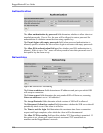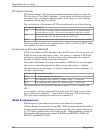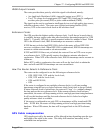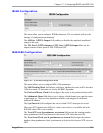
Chapter 27 - Configuring IRIGB And IEEE1588
IRIGB Output Formats
The router provides three ports by which the signal is distributed, namely:
• An Amplitude Modulated (AM) sinusoidal output port (PTP1),
• Two TTL voltage level output ports (PTP2 and PTP3) which may be configured
as either pulse per second (PPS) or pulse width modulated (PWM).
The signal can be used to synchronize intelligent devices to a high quality time source,
called the reference clock. The router uses a global positioning satellite (GPS)
receiver, NTP or the router's local clock as the reference clock.
Reference Clocks
The GPS provides the highest quality reference clock. It will always be used when it
is available, but may require some time after boot before becoming acquired (or “GPS
locked”). Typically, GPS lock is usually acquired within five minutes of boot. When
GPS is the reference clock, IRIG-B timestamps are accurate to within ns.
If GPS has not yet locked and IEEE1588 is locked, the router will use IEEE1588
server as a reference clock. When IEEE1588 is synchronized, IRIG-B timestamps are
accurate to within microsecond or sub microseconds.
If GPS and IEEE1588 have not yet locked, the router will use an NTP server or peer
as a reference clock. NTP typically requires less than two minutes after boot to
synchronize. When NTP is the reference clock, IRIG-B timestamps can be accurate to
within ms.
Before NTP is able to synchronize, the router will use the local clock to obtain the
time and will emit IRIG-B timestamps on a one second basis.
How The Router Selects A Reference Clock
The router can be configured to use the following as reference clocks:
• GPS, IEEE1588, NTP and the local clock,
• GPS, NTP and the local clock,
• GPS and IEEE1588,
• GPS
If the router is configured to use multiple reference clocks, it will start sending
timestamps using the best ever locked reference clock (local clock is always locked).
If better reference clock is locked later, the router will “step” (i.e. suddenly change)
the time and use the new reference clock. If the current reference clock becomes
unavailable, the router will keep running with its own high precision timing hardware.
It will use this hardware until the last used reference clock is locked or a higher
quality reference clock is available.
If the router is configured to use only GPS, no timestamps will be issued until GPS
locks. If GPS fails, the router will keep running with its own high precision timing
hardware. When GPS returns, the time will be stepped back to the GPS reference
clock.
GPS Cable compensation
GPS signals received by the antenna will be delayed in time depending upon the type
and length of the cable to the router. This delay will introduce inaccuracy in the
calculated time and position.
RuggedCom 243


















